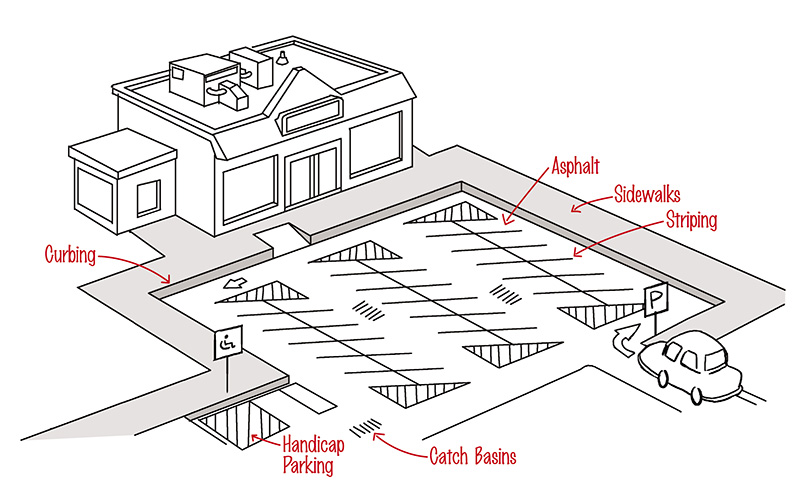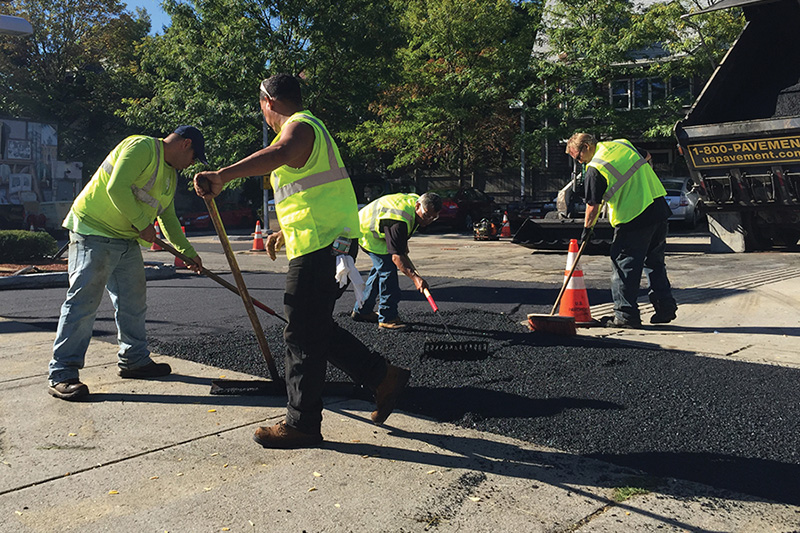The condition of your parking lot tells your customers a story.
By Andrew Musto
There is an old saying in business: “How you do anything is how you do everything.” For restaurateurs, this means that a long wait for a table can be overcome by an adjacent bar and an exquisite meal can be undermined by a filthy bathroom. Everything matters.
With that in mind, how important are first impressions? How you present yourself the very first time is a strong indicator of how the rest of your guest’s experience will be interpreted. More so than any other business, restaurants must instill total confidence in its patrons in order to attract and keep loyal customers. Your customers rely on you to be clean, safe and properly equipped to store, prepare and serve food on their behalf. It’s an ongoing responsibility which requires hundreds, if not thousands, of quality assurances by individual restaurants and is done out of sight of most guests. Multiply that by portfolios regionally and nationwide and the challenges become daunting, it may seem. The truth is, most successful restaurant groups do an excellent job of not only maintaining high standards of quality but often exceed required benchmarks in order to meet brand mandates.
 With so much invested in the customer experience behind the scenes and so much competition for market share, shouldn’t your parking lot be an indicator of the same impeccable standards your brand represents? Shouldn’t the very first physical contact your patrons have with the property receive just as much care and attention as all of your other quality controlled systems? Sometime after your social media shoutout online but before the host greets guests once they are inside, for better or worse your parking lot has already made a lasting first impression.
With so much invested in the customer experience behind the scenes and so much competition for market share, shouldn’t your parking lot be an indicator of the same impeccable standards your brand represents? Shouldn’t the very first physical contact your patrons have with the property receive just as much care and attention as all of your other quality controlled systems? Sometime after your social media shoutout online but before the host greets guests once they are inside, for better or worse your parking lot has already made a lasting first impression.
When restaurants approach managing their asphalt and concrete programs, it’s important to focus on a few factors. Depending on the local climate and age and condition of the asphalt surface, most paving and pavement maintenance issues generally come down to two critical processes: repair or replace. When considering your plan of action, first have an experienced professional conduct an immediate need evaluation. This is a crucial step and could mean the difference between keeping your establishment open or not in a lot of cases. This initial status review will identify general safety issues such as trip hazards, customer accessibility and overall lot conditions. A well-considered evaluation at the outset plots the most cost-effective course for individual properties and the entire property group.
 Repair
Repair
The liability associated with trip-and-fall incidents on property alone makes having a proactive asphalt repair schedule a business essential. Whether it’s severe trip hazards left unchecked or basic accessibility issues that remain unresolved, your parking lot can present safety issues that require immediate attention. Once an onsite assessment takes place to evaluate the liability needs, there are several cost-effective solutions available. Repairs generally cover minor cracking, surface deterioration and normal wear that naturally occur over time. Crack filling, pothole and patching repairs, infrared asphalt repairs, sealcoating and restriping are among the solutions available. These budget-friendly options serve two purposes. First, an established asphalt maintenance program saves money over time while reducing your liabilities. Like painting a house, a revitalized parking lot is an immediate cosmetic upgrade to your property.
Replacement
When a parking lot assessment reveals severe rutting, exposed sub-base, alligatoring and inadequate drainage causing accelerated deterioration, a complete repaving of the lot is needed. Replacement work means larger and more equipment and a larger crew on-site. An asphalt replacement project requires detailed planning and coordination to ensure minimal disruption to customers and business operations. Once a scope is recommended, special consideration is given to peak customer activity around breakfast, lunch and dinner for restaurants. Drive-thru lanes, customer parking and ADA accessibility and compliance — along with construction flow and efficiency — all factor into a comprehensive asphalt replacement plan. When budgets allow, overnight milling and paving is part of the overall solution.
 Bidding
Bidding
Restaurant facility managers should look for several important components when considering bids for parking lot work. Of course budgets ultimately rule the day but the lowest bid theory is not necessarily the built in decision-maker here. Whether it’s a repair or replacement bid, ask if the contractor has bundled offerings. Bundled or packaged offerings bring the costs of the work down. Because not all properties are created equal, bundled offerings present a tremendous savings opportunity for owners. Owners should also consider value-added upgrades such as sidewalks, signage and aftercare. Aftercare is a chance to initiate a full maintenance program for your parking lot needs at a strategic point in negotiations with potential contractors. Any contractor worth your business should have the flexibility to tailor bids to your needs and also present scalable programs with multiple phases included.
SIDEBAR:
Terms of the Trade
It’s important to be familiar with the terms of parking lot maintenance to better understand the scope of repair and replacement options:
• The crack filling process is the first line of defense in preventing the degradation of your pavement. Cracks are filled using a hot-applied rubberized joint sealant that exceeds Federal specifications. Afterward, a light aggregate material is added to the hot rubber to improve adhesion. The process is sometimes referred to as crack sealing.
• When moisture seeps into the pavement and contracts or expands, potholes are created. These bowl-shaped openings can be up to 10 inches deep and inflict severe damage on passing vehicles. As more traffic drives over these weakened areas, it eventually crumbles and breaks away. Patching is the process of repairing failed pavement with asphalt patching by first identifying and then excavating the problem areas and raking in fresh asphalt.
• Infrared repair is the process of heating up existing asphalt to a workable temperature (300°F), then removing the deteriorated pavement 3 inches to 4 inches deep. New replacement asphalt is raked in and compacted with a vibratory roller. Infrared repairs are the most cost-effective type of asphalt repair: The finished product has the same or better life expectancy as the surrounding asphalt, and it costs far less than getting the pavement removed wholesale.
• Sealcoating is protective coating applied to pavement that’s invulnerable to destructive elements including weather conditions and ultraviolet rays. Sealcoating is a proven way to protect your property and prevent further damage and costs down the line.
• Striping or restriping, often done in conjunction with sealcoating, is the process of painting pavement markings that control vehicle and pedestrian traffic, including crosswalks, arrows, disabled parking symbols and parking stalls. — Andrew Musto
— Andrew Musto is chief operating officer of U.S. Pavement Services, Inc., which consists of more than 150 employees, many of whom have been with the company for more than 15 years, and the 1-800-PAVEMENT network, consisting of more than 240 pavement and asphalt maintenance contractors throughout the U.S. and Canada. Email the author at [email protected].
